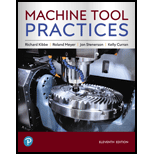
Machine Tool Practices
11th Edition
ISBN: 9780134985848
Author: Richard R. Kibbe; Roland O. Meyer; Jon Stenerson; Kelly Curran
Publisher: Pearson Education (US)
expand_more
expand_more
format_list_bulleted
Concept explainers
Textbook Question
Chapter B.9, Problem 8ST
What is the purpose of the wheel blotter?
Expert Solution & Answer
Want to see the full answer?
Check out a sample textbook solution
Students have asked these similar questions
Example-1:
l
D
A uniform rotor of length 0.6 m and diameter 0.4 m is made of steel (density 7810 kg/m³)
is supported by identical short bearings of stiffness 1 MN/m in the horizontal and vertical
directions. If the distance between the bearings is 0.7 m, determine the natural frequencies
and plot whirl speed map.
Solution:
B
find the laplace transform for the
flowing function
2(1-e)
Ans. F(s)=-
S
12)
k
0
Ans. F(s)=
k
s(1+e)
0 a
2a 3a 4a
13)
2+
Ans. F(s)=
1
s(1+e")
3
14) f(t)=1, 0
Find the solution of the following Differential Equations
Using Laplace Transforms
1) 4y+2y=0.
y(0)=2.
y'(0)=0.
2) y+w²y=0,
(0)=A,
y'(0)=B.
3) +2y-8y 0.
y(0)=1.
y'(0)-8.
4)-2-3y=0,
y(0)=1.
y'(0)=7.
5) y-ky'=0,
y(0)=2,
y'(0)=k.
6) y+ky'-2k²y=0,
y(0)=2,
y'(0) = 2k.
7) '+4y=0,
y(0)=2.8
8) y+y=17 sin(21),
y(0)=-1.
9) y-y-6y=0,
y(0)=6,
y'(0)=13.
10) y=0.
y(0)=4,
y' (0)=0.
11) -4y+4y-0,
y(0)=2.1.
y'(0)=3.9
12) y+2y'+2y=0,
y(0)=1,
y'(0)=-3.
13) +7y+12y=21e".
y(0)=3.5.
y'(0)=-10.
14) "+9y=10e".
y(0)=0,
y'(0)=0.
15) +3y+2.25y=91' +64.
y(0)=1.
y'(0) = 31.5
16)
-6y+5y-29 cos(2t).
y(0)=3.2,
y'(0)=6.2
17) y+2y+2y=0,
y(0)=0.
y'(0)=1.
18) y+2y+17y=0,
y(0)=0.
y'(0)=12.
19) y"-4y+5y=0,
y(0)=1,
y'(0)=2.
20) 9y-6y+y=0,
(0)-3,
y'(0)=1.
21) -2y+10y=0,
y(0)=3,
y'(0)=3.
22) 4y-4y+37y=0,
y(0)=3.
y'(0)=1.5
23) 4y-8y+5y=0,
y(0)=0,
y'(0)=1.
24)
++1.25y-0,
y(0)=1,
y'(0)=-0.5
25) y 2 cos(r).
y(0)=2.
y'(0) = 0.
26)
-4y+3y-0,
y(0)=3,
y(0) 7.
27) y+2y+y=e
y(0)=0.
y'(0)=0.
28) y+2y-3y=10sinh(27),
y(0)=0.
y'(0)=4.
29)…
Chapter B Solutions
Machine Tool Practices
Ch. B.1 - List several uses of the arbor press.Ch. B.1 - A newly machined steel shaft with an interference...Ch. B.1 - The ram of an arbor press is loose in its guide...Ch. B.1 - When a bushing is pushed into a bore that is...Ch. B.1 - Prob. 5STCh. B.1 - What difference is there in the way a press fit is...Ch. B.1 - Prior to installing a bushing with the arbor...Ch. B.1 - Name five ways to avoid tool breakage and other...Ch. B.2 - Name two types of bench visesCh. B.2 - Prob. 2ST
Ch. B.2 - How can the finished surface of a part be...Ch. B.2 - Name three things that should never be done to a...Ch. B.2 - How should a vise be Lubricated?Ch. B.2 - Prob. 6STCh. B.2 - What advantage does the lever-jawed wrench offer...Ch. B.2 - Some objects should never be struck with a hard...Ch. B.2 - Why should pipe wrenches never be used on bolts,...Ch. B.2 - What are the two important things to remember...Ch. B.3 - What is the kerf?Ch. B.3 - What is the set on a saw blade?Ch. B.3 - What is the pitch of the hacksaw blade?Ch. B.3 - What determines the selection of a saw blade for a...Ch. B.3 - Hand hacksaw blades fall into two basic...Ch. B.3 - Give four causes that make saw blades dull.Ch. B.3 - Give two reasons why hacksaw blades break.Ch. B.3 - A new hacksaw blade should not be used in a cut...Ch. B.4 - What are the four different cuts found on files?Ch. B.4 - Name four coarseness designations for files.Ch. B.4 - Which of the two kinds of files-single cut or...Ch. B.4 - What are the coarseness designations for needle...Ch. B.4 - Prob. 5STCh. B.4 - What causes a file to get dull?Ch. B.4 - Why should a handle be used on a file?Ch. B.4 - How does the hardness of a workpiece affect the...Ch. B.4 - Should pressure be applied to a file on the return...Ch. B.4 - Why is a round file rotated while it is being...Ch. B.5 - Prob. 1STCh. B.5 - What is the purpose of a starting taper on a...Ch. B.5 - What is the advantage of a spiral flute reamer...Ch. B.5 - How does the shank diameter of a hand reamer...Ch. B.5 - Prob. 5STCh. B.5 - Prob. 6STCh. B.5 - What is the purpose of cutting fluid in reaming?Ch. B.5 - Prob. 8STCh. B.5 - How much reaming allowance is left for hand...Ch. B.5 - If you were repairing the lathe tailstock taper,...Ch. B.6 - What type of tap is used to produce threads that...Ch. B.6 - Prob. 2STCh. B.6 - Prob. 3STCh. B.6 - When is a spiral fluted tap used?Ch. B.6 - How are thread-forming taps different from...Ch. B.6 - How are taper pipe taps identified?Ch. B.6 - Why are finishing and roughing Acme taps used?Ch. B.6 - Why are rake angles varied on taps for different...Ch. B.7 - What kind of tools are used to drive taps when...Ch. B.7 - What is a hand tapper?Ch. B.7 - What is a tapping attachment?Ch. B.7 - Which three factors affect the strength of a...Ch. B.7 - How deep should the usable threads be in a tapped...Ch. B.7 - What causes taps to break while tapping?Ch. B.7 - What causes rough and tom threads?Ch. B.7 - Give three methods of removing broken taps from...Ch. B.8 - What is a die?Ch. B.8 - What tool is used to drive a die?Ch. B.8 - How much adjustment is possible with a round split...Ch. B.8 - What are important points to watch when assembling...Ch. B.8 - Why do dies have a chamfer on the cutting end?Ch. B.8 - Why are cutting fluids used?Ch. B.8 - What diameter should a rod be before being...Ch. B.8 - Why should a rod be chamfered before being...Ch. B.9 - Prob. 1STCh. B.9 - Why should a tool grinder never be used for rough...Ch. B.9 - Prob. 3STCh. B.9 - Prob. 4STCh. B.9 - Prob. 5STCh. B.9 - Prob. 6STCh. B.9 - Prob. 7STCh. B.9 - What is the purpose of the wheel blotter?Ch. B.9 - Prob. 9STCh. B.9 - What does the wheel ring test do?
Knowledge Booster
Learn more about
Need a deep-dive on the concept behind this application? Look no further. Learn more about this topic, mechanical-engineering and related others by exploring similar questions and additional content below.Similar questions
- Auto Controls A union feedback control system has the following open loop transfer function where k>0 is a variable proportional gain i. for K = 1 , derive the exact magnitude and phase expressions of G(jw). ii) for K = 1 , identify the gaincross-over frequency (Wgc) [where IG(jo))| 1] and phase cross-overfrequency [where <G(jw) = - 180]. You can use MATLAB command "margin" to obtain there quantities. iii) Calculate gain margin (in dB) and phase margin (in degrees) ·State whether the closed-loop is stable for K = 1 and briefly justify your answer based on the margin . (Gain marginPhase margin) iv. what happens to the gain margin and Phase margin when you increase the value of K?you You can use for loop in MATLAB to check that.Helpful matlab commands : if, bode, margin, rlocus NO COPIED SOLUTIONSarrow_forwardThe 120 kg wheel has a radius of gyration of 0.7 m. A force P with a magnitude of 50 N is applied at the edge of the wheel as seen in the diagram. The coefficient of static friction is 0.3, and the coefficient of kinetic friction is 0.25. Find the acceleration and angular acceleration of the wheel.arrow_forwardAuto Controls Using MATLAB , find the magnitude and phase plot of the compensators NO COPIED SOLUTIONSarrow_forward
- 4-81 The corner shown in Figure P4-81 is initially uniform at 300°C and then suddenly exposed to a convection environment at 50°C with h 60 W/m². °C. Assume the = 2 solid has the properties of fireclay brick. Examine nodes 1, 2, 3, 4, and 5 and deter- mine the maximum time increment which may be used for a transient numerical calculation. Figure P4-81 1 2 3 4 1 cm 5 6 1 cm 2 cm h, T + 2 cmarrow_forwardAuto Controls A union feedback control system has the following open loop transfer function where k>0 is a variable proportional gain i. for K = 1 , derive the exact magnitude and phase expressions of G(jw). ii) for K = 1 , identify the gaincross-over frequency (Wgc) [where IG(jo))| 1] and phase cross-overfrequency [where <G(jw) = - 180]. You can use MATLAB command "margin" to obtain there quantities. iii) Calculate gain margin (in dB) and phase margin (in degrees) ·State whether the closed-loop is stable for K = 1 and briefly justify your answer based on the margin . (Gain marginPhase margin) iv. what happens to the gain margin and Phase margin when you increase the value of K?you You can use for loop in MATLAB to check that.Helpful matlab commands : if, bode, margin, rlocus NO COPIED SOLUTIONSarrow_forwardAuto Controls Hand sketch the root Focus of the following transfer function How many asymptotes are there ?what are the angles of the asymptotes?Does the system remain stable for all values of K NO COPIED SOLUTIONSarrow_forward
- Please draw the section view of the following problemsarrow_forward7) Please draw the front, top and side view for the following object. Please cross this line outarrow_forwardA 10-kg box is pulled along P,Na rough surface by a force P, as shown in thefigure. The pulling force linearly increaseswith time, while the particle is motionless att = 0s untilit reaches a maximum force of100 Nattimet = 4s. If the ground has staticand kinetic friction coefficients of u, = 0.6 andHU, = 0.4 respectively, determine the velocityof the A 1 0 - kg box is pulled along P , N a rough surface by a force P , as shown in the figure. The pulling force linearly increases with time, while the particle is motionless at t = 0 s untilit reaches a maximum force of 1 0 0 Nattimet = 4 s . If the ground has static and kinetic friction coefficients of u , = 0 . 6 and HU , = 0 . 4 respectively, determine the velocity of the particle att = 4 s .arrow_forward
arrow_back_ios
SEE MORE QUESTIONS
arrow_forward_ios
Recommended textbooks for you
 Automotive Technology: A Systems Approach (MindTa...Mechanical EngineeringISBN:9781133612315Author:Jack Erjavec, Rob ThompsonPublisher:Cengage Learning
Automotive Technology: A Systems Approach (MindTa...Mechanical EngineeringISBN:9781133612315Author:Jack Erjavec, Rob ThompsonPublisher:Cengage Learning Precision Machining Technology (MindTap Course Li...Mechanical EngineeringISBN:9781285444543Author:Peter J. Hoffman, Eric S. Hopewell, Brian JanesPublisher:Cengage Learning
Precision Machining Technology (MindTap Course Li...Mechanical EngineeringISBN:9781285444543Author:Peter J. Hoffman, Eric S. Hopewell, Brian JanesPublisher:Cengage Learning Automotive TechnologyMechanical EngineeringISBN:9781337794213Author:ERJAVEC, Jack.Publisher:Cengage,
Automotive TechnologyMechanical EngineeringISBN:9781337794213Author:ERJAVEC, Jack.Publisher:Cengage,

Automotive Technology: A Systems Approach (MindTa...
Mechanical Engineering
ISBN:9781133612315
Author:Jack Erjavec, Rob Thompson
Publisher:Cengage Learning

Precision Machining Technology (MindTap Course Li...
Mechanical Engineering
ISBN:9781285444543
Author:Peter J. Hoffman, Eric S. Hopewell, Brian Janes
Publisher:Cengage Learning

Automotive Technology
Mechanical Engineering
ISBN:9781337794213
Author:ERJAVEC, Jack.
Publisher:Cengage,
Mechanical Design (Machine Design) Clutches, Brakes and Flywheels Intro (S20 ME470 Class 15); Author: Professor Ted Diehl;https://www.youtube.com/watch?v=eMvbePrsT34;License: Standard Youtube License